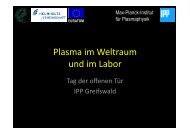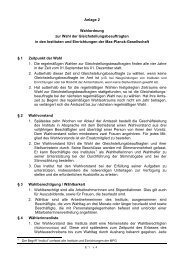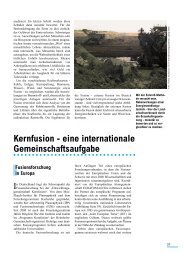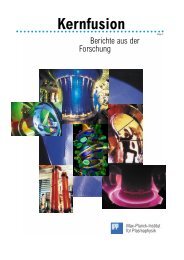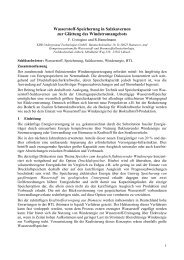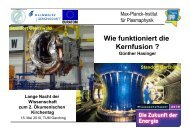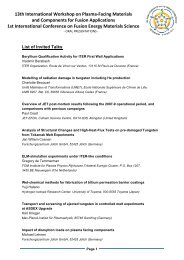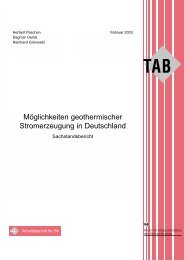IPP Annual Report 2007 - Max-Planck-Institut für Plasmaphysik ...
IPP Annual Report 2007 - Max-Planck-Institut für Plasmaphysik ...
IPP Annual Report 2007 - Max-Planck-Institut für Plasmaphysik ...
Create successful ePaper yourself
Turn your PDF publications into a flip-book with our unique Google optimized e-Paper software.
flux across the separatrix due to classical ion B×B drifts:<br />
strong influx at the top of the plasma, and outflux above the<br />
X-point. The comparison of the experimental and simulation<br />
data was facilitated via common, MDSplus-based databases<br />
generated under the auspices of the ITPA Divertor and SOL<br />
working group.<br />
9.2 EURATOM Associations<br />
The participation of scientists from EURATOM Associations<br />
continued to stay at a high level as in previous years.<br />
In response to the call for participation in the 2008 AUG<br />
campaign more than 160 experimental proposals have been<br />
submitted by 75 scientists. More than 50 % of them are<br />
non-<strong>IPP</strong> scientists. Besides several proposals from DIII-D,<br />
the majority of external proposals originate from scientists<br />
of 14 different EU Associations. In total the execution of<br />
more than 1400 discharges has been requested. The international<br />
AUG Programme Committee met in December and<br />
approved a prioritized programme of roughly 800 shots.<br />
Besides <strong>IPP</strong> ten Associations are represented in this body.<br />
Andrew Kirk a scientist from MAST will take over the<br />
management of the AUG Task Force III “SOL & Divertor<br />
physics and first wall materials”. In the following the most<br />
important contributions from Associations made in <strong>2007</strong><br />
are summarized.<br />
DCU – University College Cork:<br />
Progress made during <strong>2007</strong> in the context of the ongoing<br />
collaboration between <strong>IPP</strong> and University College Cork is<br />
summarized as follows: A significant effort was expended<br />
on CLISTE reconstructions as part of the recalibration of<br />
the MSE diagnostic in light of systematic corrections to<br />
radial channel locations discovered in early <strong>2007</strong>. These<br />
involved analysis of discharges with maximal diagnostic<br />
information on rational surface locations to validate q profiles<br />
obtained with MSE.<br />
CLISTE has been extended to improve the modelling of disrupting<br />
plasmas and now can generate interpretive equilibria<br />
(including halo currents) for plasmas as small as 20 cm in<br />
radius resting on divertor structures. The predictive Garching<br />
Equilibrium Code can now generate ITER equilibria in AUG<br />
shotfile format and construction of a database is underway.<br />
The study of TAE character and stability has been completed<br />
from discharges performed during the 2006 experimental<br />
campaign for cases with ICRH only and combined ICRH<br />
and NBI. Using MSE data, the quality of current profile<br />
reconstructions using TAE mode positions from ICRH-only<br />
discharges and ICRH with beatwaves has been confirmed.<br />
These results will be used to describe in detail the nature and<br />
uses of TAE in ASDEX Upgrade. TAE were also observed<br />
in discharges from the first period of the <strong>2007</strong> campaign, the<br />
first using a full tungsten machine. TAE activity from these<br />
discharges differs significantly from the previous campaign<br />
and analysis of the data is in progress.<br />
ASDEX Upgrade<br />
22<br />
ENEA – Consorzio RFX, Padova:<br />
The ORBIT code has been used to study the fast ion<br />
dynamics in AUG and thus to contribute to the analysis of<br />
the fast ion loss diagnostic measurements (FILD). Several<br />
improvements and corrections have been implemented in<br />
the code in order to perform more realistic simulations to<br />
be compared with experimental data. In particular, the use<br />
of equilibria in straight field lines has been assessed; this has<br />
allowed fast ion physics to be studied in the real D-shaped<br />
geometry of the device instead of a circular approximation<br />
with Boozer co-ordinates. The equilibrium quantities are<br />
computed by the VMEC code and adapted to be accessible<br />
by ORBIT. The main application of the code has been a<br />
study of the fast ion losses induced by Neoclassical Tearing<br />
Modes. The influence of the toroidal magnetic field ripple<br />
has been studied as well. As a further improvement electric<br />
field effects have been implemented to deal with rotating<br />
NTMs. An algorithm to obtain stationary conditions has<br />
been introduced by replacing the lost deuterons with new<br />
ones belonging to the same space and velocity distribution,<br />
which characterizes the ions injected by the NBI system.<br />
Simulations with rotating modes have confirmed most of<br />
the results performed with a stationary mode. It has been<br />
observed that at higher mode rotation frequencies larger<br />
losses occur. This partly agrees with the experimental data,<br />
but further analysis is still needed. In addition, investigations<br />
of the internal structure of TAE modes are reported in<br />
section 6.4.<br />
HAS – KFKI Budapest:<br />
The triggering mechanism of type-III ELMs was investigated<br />
in detail by linking the dynamics of pellet-triggered<br />
ELMs to the pellet trajectory. In order to study the pelletinduced<br />
perturbation which triggers the ELM, magnetic<br />
pick-up coil signals were analysed in ohmic discharges.<br />
Methane doped deuterium pellet experiments were carried<br />
out to study the effect of doping on penetration and pellet<br />
cloud properties. Pellets with methane content between 0.44<br />
and 2.4 % were used.<br />
The effect of pellet injection on target plasma radiation was<br />
investigated by the multi-chord SXR and bolometer systems.<br />
An increase of the total radiation during pellet injection was<br />
observed showing radiation coming from the HFS where the<br />
pellet is ablated. SXR investigations revealed a poloidally<br />
symmetric decrease of the plasma emissivity propagating<br />
inwards during pellet ablation (see section 6.7). Temperature<br />
measurements indicate that the emissivity drop is caused by<br />
the cooling of the plasma.<br />
Further testing was done with a new Lithium ion source<br />
with a surface twice that of the usual one. Although up to<br />
6 mA ion current could be reached the long term reliability<br />
of the source is still not sufficient. The possibility of density<br />
fluctuation measurement using the AUG lithium beam diagnostic<br />
was studied with a single channel observation system.




